Trauma Informed Care Principles and Application: Mike's Case Study
VerifiedAdded on 2023/01/18
|9
|2797
|64
Report
AI Summary
This report delves into the application of trauma informed care principles through a case study of Mike, a late-40s athlete grappling with depression, bipolar disorder, and substance abuse. The analysis explores the factors contributing to Mike's condition, including the pressures of his athletic career, emotional detachment, and the gulf between expectations and reality. The report examines how trauma informed care principles, such as safety, trustworthiness, and empowerment, can be applied to address Mike's challenges. It emphasizes the importance of nurses understanding the root causes of substance abuse and mental health issues, and working collaboratively with patients to offer effective treatment, including the potential use of multidisciplinary teams. The report also highlights the significance of considering social, cultural, and gender aspects in providing care, along with the use of tools like the Medical Statement Examination to assess patients' conditions and recommend specialized treatment when needed. The study underscores the need for healthcare professionals to adhere to trauma informed care principles to enhance the quality and effectiveness of treatment services, ultimately facilitating patient recovery.
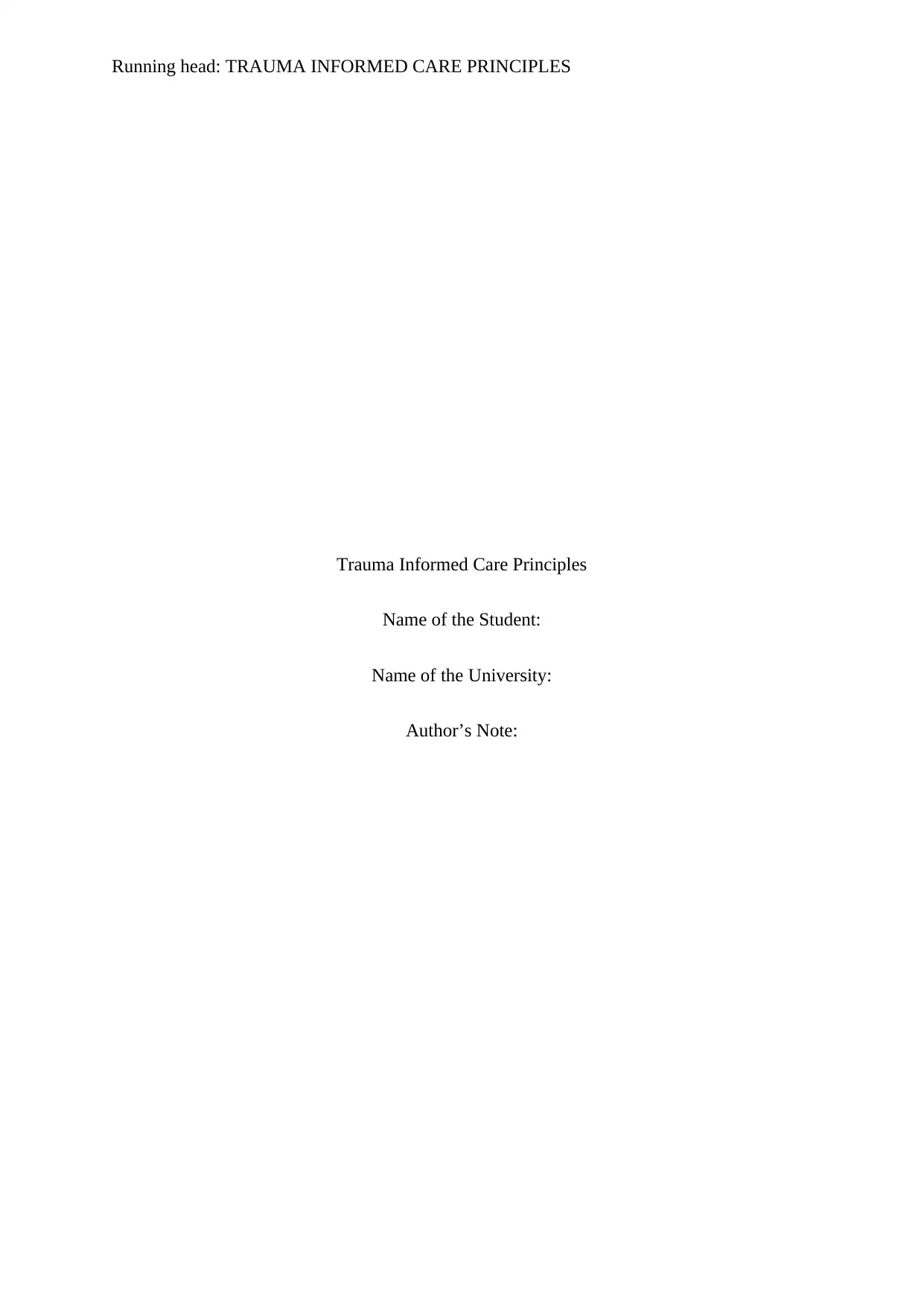
Running head: TRAUMA INFORMED CARE PRINCIPLES
Trauma Informed Care Principles
Name of the Student:
Name of the University:
Author’s Note:
Trauma Informed Care Principles
Name of the Student:
Name of the University:
Author’s Note:
Paraphrase This Document
Need a fresh take? Get an instant paraphrase of this document with our AI Paraphraser
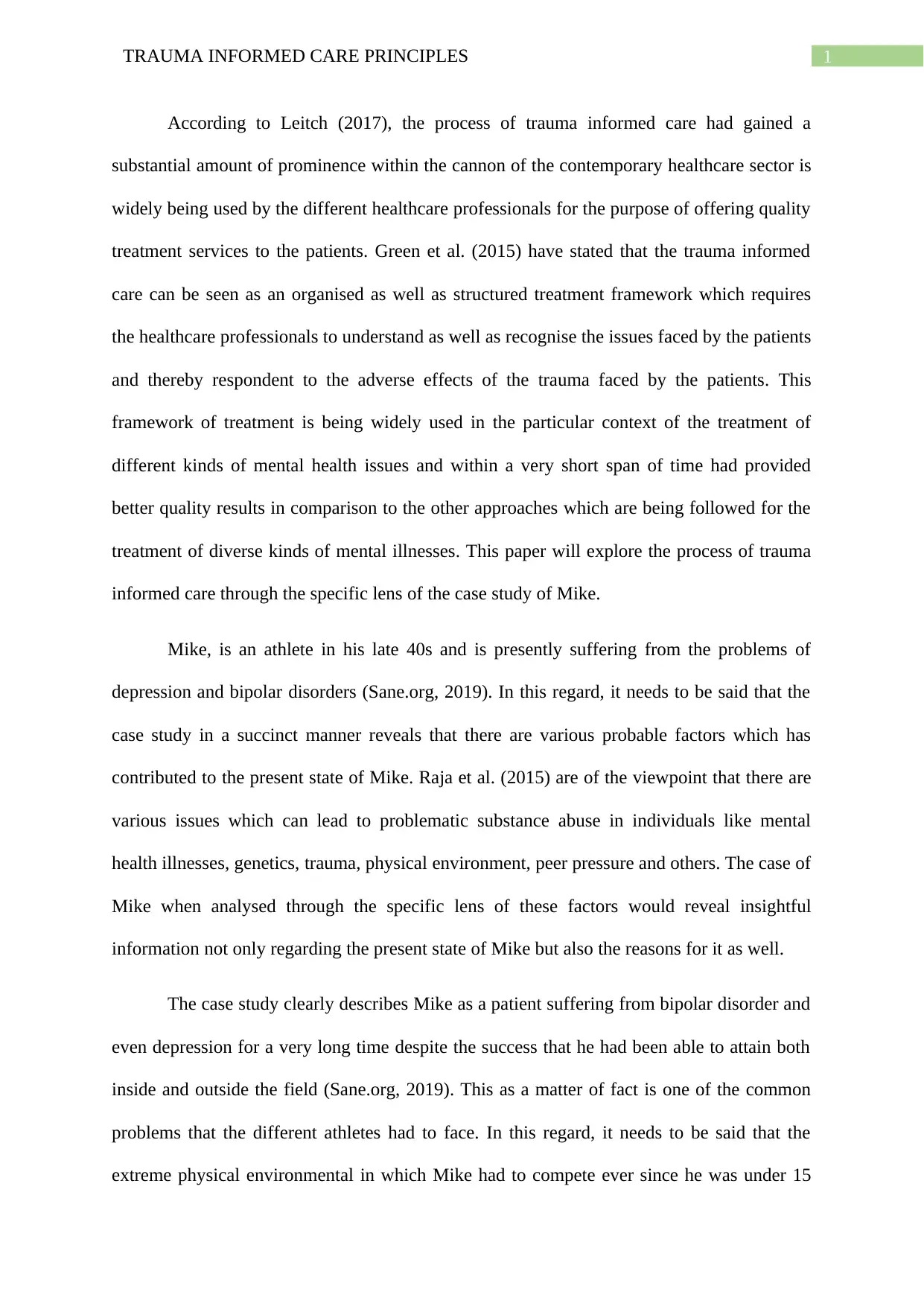
1TRAUMA INFORMED CARE PRINCIPLES
According to Leitch (2017), the process of trauma informed care had gained a
substantial amount of prominence within the cannon of the contemporary healthcare sector is
widely being used by the different healthcare professionals for the purpose of offering quality
treatment services to the patients. Green et al. (2015) have stated that the trauma informed
care can be seen as an organised as well as structured treatment framework which requires
the healthcare professionals to understand as well as recognise the issues faced by the patients
and thereby respondent to the adverse effects of the trauma faced by the patients. This
framework of treatment is being widely used in the particular context of the treatment of
different kinds of mental health issues and within a very short span of time had provided
better quality results in comparison to the other approaches which are being followed for the
treatment of diverse kinds of mental illnesses. This paper will explore the process of trauma
informed care through the specific lens of the case study of Mike.
Mike, is an athlete in his late 40s and is presently suffering from the problems of
depression and bipolar disorders (Sane.org, 2019). In this regard, it needs to be said that the
case study in a succinct manner reveals that there are various probable factors which has
contributed to the present state of Mike. Raja et al. (2015) are of the viewpoint that there are
various issues which can lead to problematic substance abuse in individuals like mental
health illnesses, genetics, trauma, physical environment, peer pressure and others. The case of
Mike when analysed through the specific lens of these factors would reveal insightful
information not only regarding the present state of Mike but also the reasons for it as well.
The case study clearly describes Mike as a patient suffering from bipolar disorder and
even depression for a very long time despite the success that he had been able to attain both
inside and outside the field (Sane.org, 2019). This as a matter of fact is one of the common
problems that the different athletes had to face. In this regard, it needs to be said that the
extreme physical environmental in which Mike had to compete ever since he was under 15
According to Leitch (2017), the process of trauma informed care had gained a
substantial amount of prominence within the cannon of the contemporary healthcare sector is
widely being used by the different healthcare professionals for the purpose of offering quality
treatment services to the patients. Green et al. (2015) have stated that the trauma informed
care can be seen as an organised as well as structured treatment framework which requires
the healthcare professionals to understand as well as recognise the issues faced by the patients
and thereby respondent to the adverse effects of the trauma faced by the patients. This
framework of treatment is being widely used in the particular context of the treatment of
different kinds of mental health issues and within a very short span of time had provided
better quality results in comparison to the other approaches which are being followed for the
treatment of diverse kinds of mental illnesses. This paper will explore the process of trauma
informed care through the specific lens of the case study of Mike.
Mike, is an athlete in his late 40s and is presently suffering from the problems of
depression and bipolar disorders (Sane.org, 2019). In this regard, it needs to be said that the
case study in a succinct manner reveals that there are various probable factors which has
contributed to the present state of Mike. Raja et al. (2015) are of the viewpoint that there are
various issues which can lead to problematic substance abuse in individuals like mental
health illnesses, genetics, trauma, physical environment, peer pressure and others. The case of
Mike when analysed through the specific lens of these factors would reveal insightful
information not only regarding the present state of Mike but also the reasons for it as well.
The case study clearly describes Mike as a patient suffering from bipolar disorder and
even depression for a very long time despite the success that he had been able to attain both
inside and outside the field (Sane.org, 2019). This as a matter of fact is one of the common
problems that the different athletes had to face. In this regard, it needs to be said that the
extreme physical environmental in which Mike had to compete ever since he was under 15
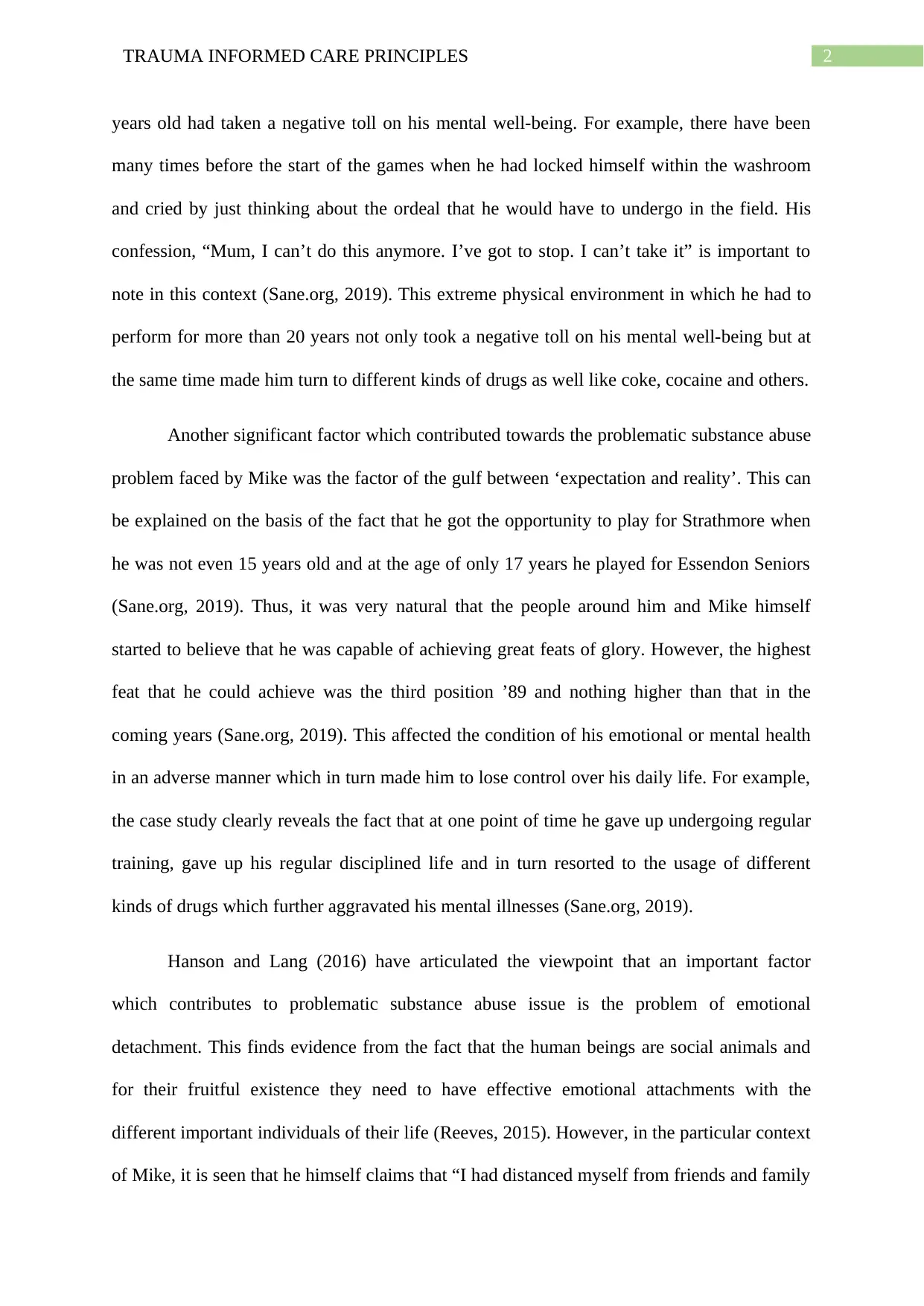
2TRAUMA INFORMED CARE PRINCIPLES
years old had taken a negative toll on his mental well-being. For example, there have been
many times before the start of the games when he had locked himself within the washroom
and cried by just thinking about the ordeal that he would have to undergo in the field. His
confession, “Mum, I can’t do this anymore. I’ve got to stop. I can’t take it” is important to
note in this context (Sane.org, 2019). This extreme physical environment in which he had to
perform for more than 20 years not only took a negative toll on his mental well-being but at
the same time made him turn to different kinds of drugs as well like coke, cocaine and others.
Another significant factor which contributed towards the problematic substance abuse
problem faced by Mike was the factor of the gulf between ‘expectation and reality’. This can
be explained on the basis of the fact that he got the opportunity to play for Strathmore when
he was not even 15 years old and at the age of only 17 years he played for Essendon Seniors
(Sane.org, 2019). Thus, it was very natural that the people around him and Mike himself
started to believe that he was capable of achieving great feats of glory. However, the highest
feat that he could achieve was the third position ’89 and nothing higher than that in the
coming years (Sane.org, 2019). This affected the condition of his emotional or mental health
in an adverse manner which in turn made him to lose control over his daily life. For example,
the case study clearly reveals the fact that at one point of time he gave up undergoing regular
training, gave up his regular disciplined life and in turn resorted to the usage of different
kinds of drugs which further aggravated his mental illnesses (Sane.org, 2019).
Hanson and Lang (2016) have articulated the viewpoint that an important factor
which contributes to problematic substance abuse issue is the problem of emotional
detachment. This finds evidence from the fact that the human beings are social animals and
for their fruitful existence they need to have effective emotional attachments with the
different important individuals of their life (Reeves, 2015). However, in the particular context
of Mike, it is seen that he himself claims that “I had distanced myself from friends and family
years old had taken a negative toll on his mental well-being. For example, there have been
many times before the start of the games when he had locked himself within the washroom
and cried by just thinking about the ordeal that he would have to undergo in the field. His
confession, “Mum, I can’t do this anymore. I’ve got to stop. I can’t take it” is important to
note in this context (Sane.org, 2019). This extreme physical environment in which he had to
perform for more than 20 years not only took a negative toll on his mental well-being but at
the same time made him turn to different kinds of drugs as well like coke, cocaine and others.
Another significant factor which contributed towards the problematic substance abuse
problem faced by Mike was the factor of the gulf between ‘expectation and reality’. This can
be explained on the basis of the fact that he got the opportunity to play for Strathmore when
he was not even 15 years old and at the age of only 17 years he played for Essendon Seniors
(Sane.org, 2019). Thus, it was very natural that the people around him and Mike himself
started to believe that he was capable of achieving great feats of glory. However, the highest
feat that he could achieve was the third position ’89 and nothing higher than that in the
coming years (Sane.org, 2019). This affected the condition of his emotional or mental health
in an adverse manner which in turn made him to lose control over his daily life. For example,
the case study clearly reveals the fact that at one point of time he gave up undergoing regular
training, gave up his regular disciplined life and in turn resorted to the usage of different
kinds of drugs which further aggravated his mental illnesses (Sane.org, 2019).
Hanson and Lang (2016) have articulated the viewpoint that an important factor
which contributes to problematic substance abuse issue is the problem of emotional
detachment. This finds evidence from the fact that the human beings are social animals and
for their fruitful existence they need to have effective emotional attachments with the
different important individuals of their life (Reeves, 2015). However, in the particular context
of Mike, it is seen that he himself claims that “I had distanced myself from friends and family
⊘ This is a preview!⊘
Do you want full access?
Subscribe today to unlock all pages.

Trusted by 1+ million students worldwide
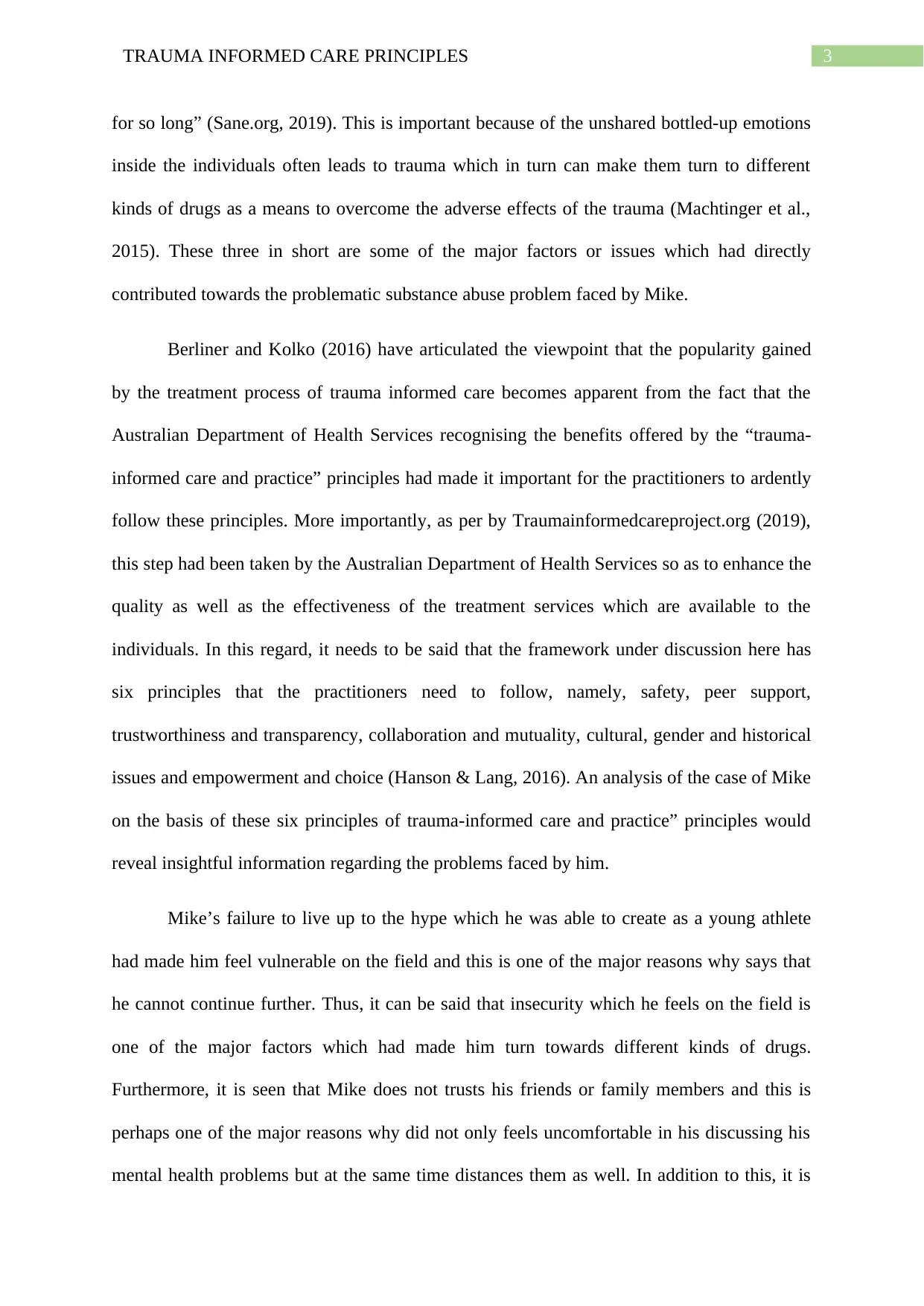
3TRAUMA INFORMED CARE PRINCIPLES
for so long” (Sane.org, 2019). This is important because of the unshared bottled-up emotions
inside the individuals often leads to trauma which in turn can make them turn to different
kinds of drugs as a means to overcome the adverse effects of the trauma (Machtinger et al.,
2015). These three in short are some of the major factors or issues which had directly
contributed towards the problematic substance abuse problem faced by Mike.
Berliner and Kolko (2016) have articulated the viewpoint that the popularity gained
by the treatment process of trauma informed care becomes apparent from the fact that the
Australian Department of Health Services recognising the benefits offered by the “trauma-
informed care and practice” principles had made it important for the practitioners to ardently
follow these principles. More importantly, as per by Traumainformedcareproject.org (2019),
this step had been taken by the Australian Department of Health Services so as to enhance the
quality as well as the effectiveness of the treatment services which are available to the
individuals. In this regard, it needs to be said that the framework under discussion here has
six principles that the practitioners need to follow, namely, safety, peer support,
trustworthiness and transparency, collaboration and mutuality, cultural, gender and historical
issues and empowerment and choice (Hanson & Lang, 2016). An analysis of the case of Mike
on the basis of these six principles of trauma-informed care and practice” principles would
reveal insightful information regarding the problems faced by him.
Mike’s failure to live up to the hype which he was able to create as a young athlete
had made him feel vulnerable on the field and this is one of the major reasons why says that
he cannot continue further. Thus, it can be said that insecurity which he feels on the field is
one of the major factors which had made him turn towards different kinds of drugs.
Furthermore, it is seen that Mike does not trusts his friends or family members and this is
perhaps one of the major reasons why did not only feels uncomfortable in his discussing his
mental health problems but at the same time distances them as well. In addition to this, it is
for so long” (Sane.org, 2019). This is important because of the unshared bottled-up emotions
inside the individuals often leads to trauma which in turn can make them turn to different
kinds of drugs as a means to overcome the adverse effects of the trauma (Machtinger et al.,
2015). These three in short are some of the major factors or issues which had directly
contributed towards the problematic substance abuse problem faced by Mike.
Berliner and Kolko (2016) have articulated the viewpoint that the popularity gained
by the treatment process of trauma informed care becomes apparent from the fact that the
Australian Department of Health Services recognising the benefits offered by the “trauma-
informed care and practice” principles had made it important for the practitioners to ardently
follow these principles. More importantly, as per by Traumainformedcareproject.org (2019),
this step had been taken by the Australian Department of Health Services so as to enhance the
quality as well as the effectiveness of the treatment services which are available to the
individuals. In this regard, it needs to be said that the framework under discussion here has
six principles that the practitioners need to follow, namely, safety, peer support,
trustworthiness and transparency, collaboration and mutuality, cultural, gender and historical
issues and empowerment and choice (Hanson & Lang, 2016). An analysis of the case of Mike
on the basis of these six principles of trauma-informed care and practice” principles would
reveal insightful information regarding the problems faced by him.
Mike’s failure to live up to the hype which he was able to create as a young athlete
had made him feel vulnerable on the field and this is one of the major reasons why says that
he cannot continue further. Thus, it can be said that insecurity which he feels on the field is
one of the major factors which had made him turn towards different kinds of drugs.
Furthermore, it is seen that Mike does not trusts his friends or family members and this is
perhaps one of the major reasons why did not only feels uncomfortable in his discussing his
mental health problems but at the same time distances them as well. In addition to this, it is
Paraphrase This Document
Need a fresh take? Get an instant paraphrase of this document with our AI Paraphraser
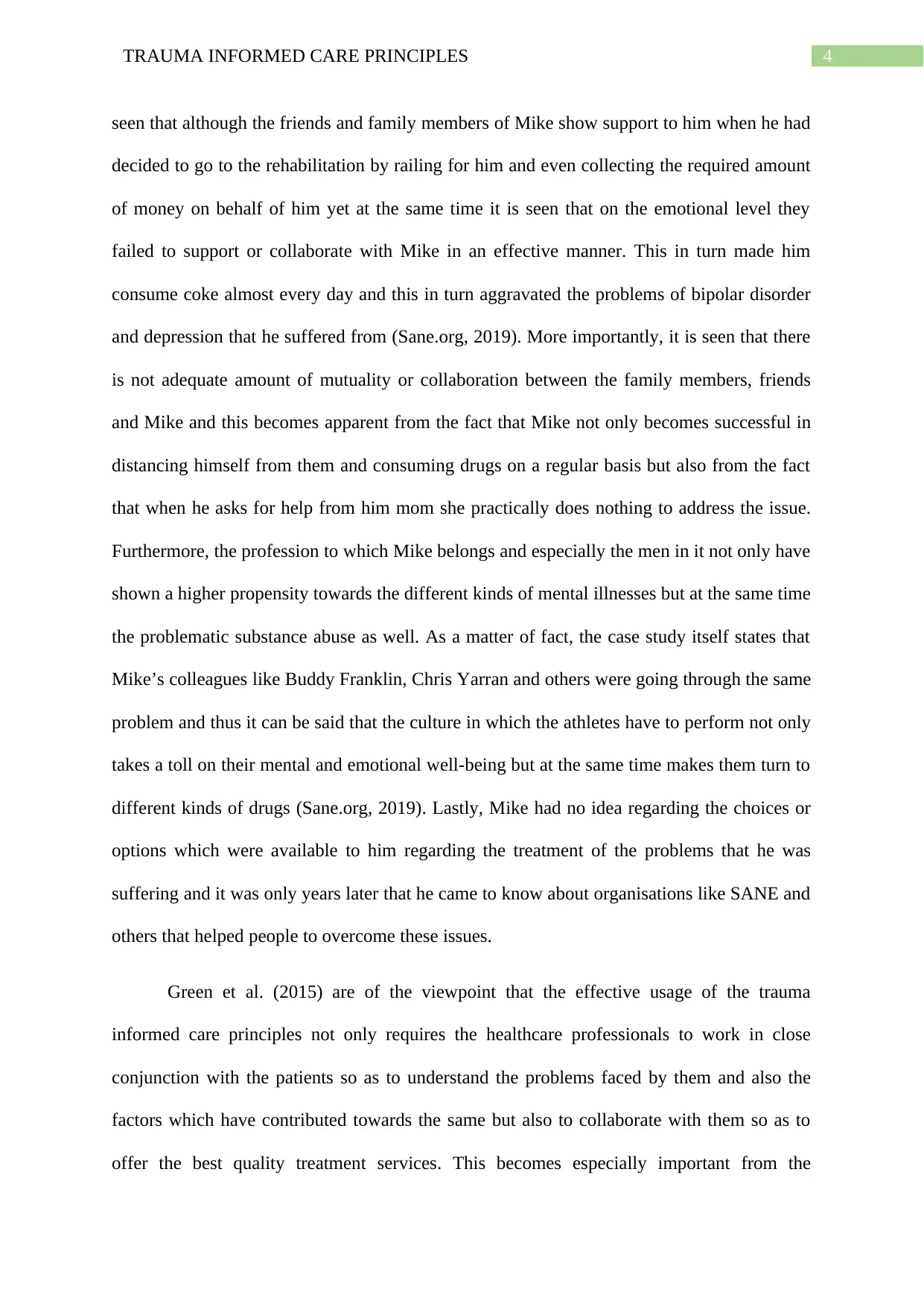
4TRAUMA INFORMED CARE PRINCIPLES
seen that although the friends and family members of Mike show support to him when he had
decided to go to the rehabilitation by railing for him and even collecting the required amount
of money on behalf of him yet at the same time it is seen that on the emotional level they
failed to support or collaborate with Mike in an effective manner. This in turn made him
consume coke almost every day and this in turn aggravated the problems of bipolar disorder
and depression that he suffered from (Sane.org, 2019). More importantly, it is seen that there
is not adequate amount of mutuality or collaboration between the family members, friends
and Mike and this becomes apparent from the fact that Mike not only becomes successful in
distancing himself from them and consuming drugs on a regular basis but also from the fact
that when he asks for help from him mom she practically does nothing to address the issue.
Furthermore, the profession to which Mike belongs and especially the men in it not only have
shown a higher propensity towards the different kinds of mental illnesses but at the same time
the problematic substance abuse as well. As a matter of fact, the case study itself states that
Mike’s colleagues like Buddy Franklin, Chris Yarran and others were going through the same
problem and thus it can be said that the culture in which the athletes have to perform not only
takes a toll on their mental and emotional well-being but at the same time makes them turn to
different kinds of drugs (Sane.org, 2019). Lastly, Mike had no idea regarding the choices or
options which were available to him regarding the treatment of the problems that he was
suffering and it was only years later that he came to know about organisations like SANE and
others that helped people to overcome these issues.
Green et al. (2015) are of the viewpoint that the effective usage of the trauma
informed care principles not only requires the healthcare professionals to work in close
conjunction with the patients so as to understand the problems faced by them and also the
factors which have contributed towards the same but also to collaborate with them so as to
offer the best quality treatment services. This becomes especially important from the
seen that although the friends and family members of Mike show support to him when he had
decided to go to the rehabilitation by railing for him and even collecting the required amount
of money on behalf of him yet at the same time it is seen that on the emotional level they
failed to support or collaborate with Mike in an effective manner. This in turn made him
consume coke almost every day and this in turn aggravated the problems of bipolar disorder
and depression that he suffered from (Sane.org, 2019). More importantly, it is seen that there
is not adequate amount of mutuality or collaboration between the family members, friends
and Mike and this becomes apparent from the fact that Mike not only becomes successful in
distancing himself from them and consuming drugs on a regular basis but also from the fact
that when he asks for help from him mom she practically does nothing to address the issue.
Furthermore, the profession to which Mike belongs and especially the men in it not only have
shown a higher propensity towards the different kinds of mental illnesses but at the same time
the problematic substance abuse as well. As a matter of fact, the case study itself states that
Mike’s colleagues like Buddy Franklin, Chris Yarran and others were going through the same
problem and thus it can be said that the culture in which the athletes have to perform not only
takes a toll on their mental and emotional well-being but at the same time makes them turn to
different kinds of drugs (Sane.org, 2019). Lastly, Mike had no idea regarding the choices or
options which were available to him regarding the treatment of the problems that he was
suffering and it was only years later that he came to know about organisations like SANE and
others that helped people to overcome these issues.
Green et al. (2015) are of the viewpoint that the effective usage of the trauma
informed care principles not only requires the healthcare professionals to work in close
conjunction with the patients so as to understand the problems faced by them and also the
factors which have contributed towards the same but also to collaborate with them so as to
offer the best quality treatment services. This becomes especially important from the

5TRAUMA INFORMED CARE PRINCIPLES
viewpoint that the traditional approaches to treatment completely disregarded the aspect of
collaboration and this in turn significantly reduced the quality or the effectiveness of the
treatment services which were being offered to the patients (Reeves, 2015). Thus, in the
particular context of Mike, the mental health nurse would not only have to take into account
the three root causes which have contributed towards his problematic substance abuse but
also the analysis of these causes on the basis of the “trauma-informed care and practice”
principles. This is important because it will not only help the nurse offer treatment to Mike
keeping into perspective these aspects of the problems faced by him but at the same time
would enable them to build trust, empower Mike and thereby facilitate the process of him
recovery at a much faster rate. Furthermore, the nurse would also have to take into account
the social, cultural, gender and other aspects of Mike while administering treatment and if
need be, recommend him to mental healthcare experts for delivering better quality treatment.
The nurses during the application as well as the usage of the trauma-informed care
and practice” principles not only need to take into account the diverse facets of the same but
also ensure that they are applying them in an effective manner because of the fact that the
negative impact of the same can adversely affect the mental well-being of the patients
(Leitch, 2017). Raja et al. (2015) have articulated the viewpoint that during the usage of this
treatment framework the nurses should take into account three factors, namely, patient well-
being, patient engagement and clinical or organised care. In addition to this, the usage of the
tool of Medical Statement Examination (MSE) is another important one which the nurses can
use to get an effective idea about the actual condition of the patients and if the results are too
serious then they can recommend such individuals to higher authorities for specialised
treatment (Reeves, 2015). In this regard, it needs to be said that presently the different
advanced healthcare units have multi-disciplinary teams which consists of psychologists,
occupational therapists, social workers, registered nurses and others so to enhance the quality
viewpoint that the traditional approaches to treatment completely disregarded the aspect of
collaboration and this in turn significantly reduced the quality or the effectiveness of the
treatment services which were being offered to the patients (Reeves, 2015). Thus, in the
particular context of Mike, the mental health nurse would not only have to take into account
the three root causes which have contributed towards his problematic substance abuse but
also the analysis of these causes on the basis of the “trauma-informed care and practice”
principles. This is important because it will not only help the nurse offer treatment to Mike
keeping into perspective these aspects of the problems faced by him but at the same time
would enable them to build trust, empower Mike and thereby facilitate the process of him
recovery at a much faster rate. Furthermore, the nurse would also have to take into account
the social, cultural, gender and other aspects of Mike while administering treatment and if
need be, recommend him to mental healthcare experts for delivering better quality treatment.
The nurses during the application as well as the usage of the trauma-informed care
and practice” principles not only need to take into account the diverse facets of the same but
also ensure that they are applying them in an effective manner because of the fact that the
negative impact of the same can adversely affect the mental well-being of the patients
(Leitch, 2017). Raja et al. (2015) have articulated the viewpoint that during the usage of this
treatment framework the nurses should take into account three factors, namely, patient well-
being, patient engagement and clinical or organised care. In addition to this, the usage of the
tool of Medical Statement Examination (MSE) is another important one which the nurses can
use to get an effective idea about the actual condition of the patients and if the results are too
serious then they can recommend such individuals to higher authorities for specialised
treatment (Reeves, 2015). In this regard, it needs to be said that presently the different
advanced healthcare units have multi-disciplinary teams which consists of psychologists,
occupational therapists, social workers, registered nurses and others so to enhance the quality
⊘ This is a preview!⊘
Do you want full access?
Subscribe today to unlock all pages.

Trusted by 1+ million students worldwide
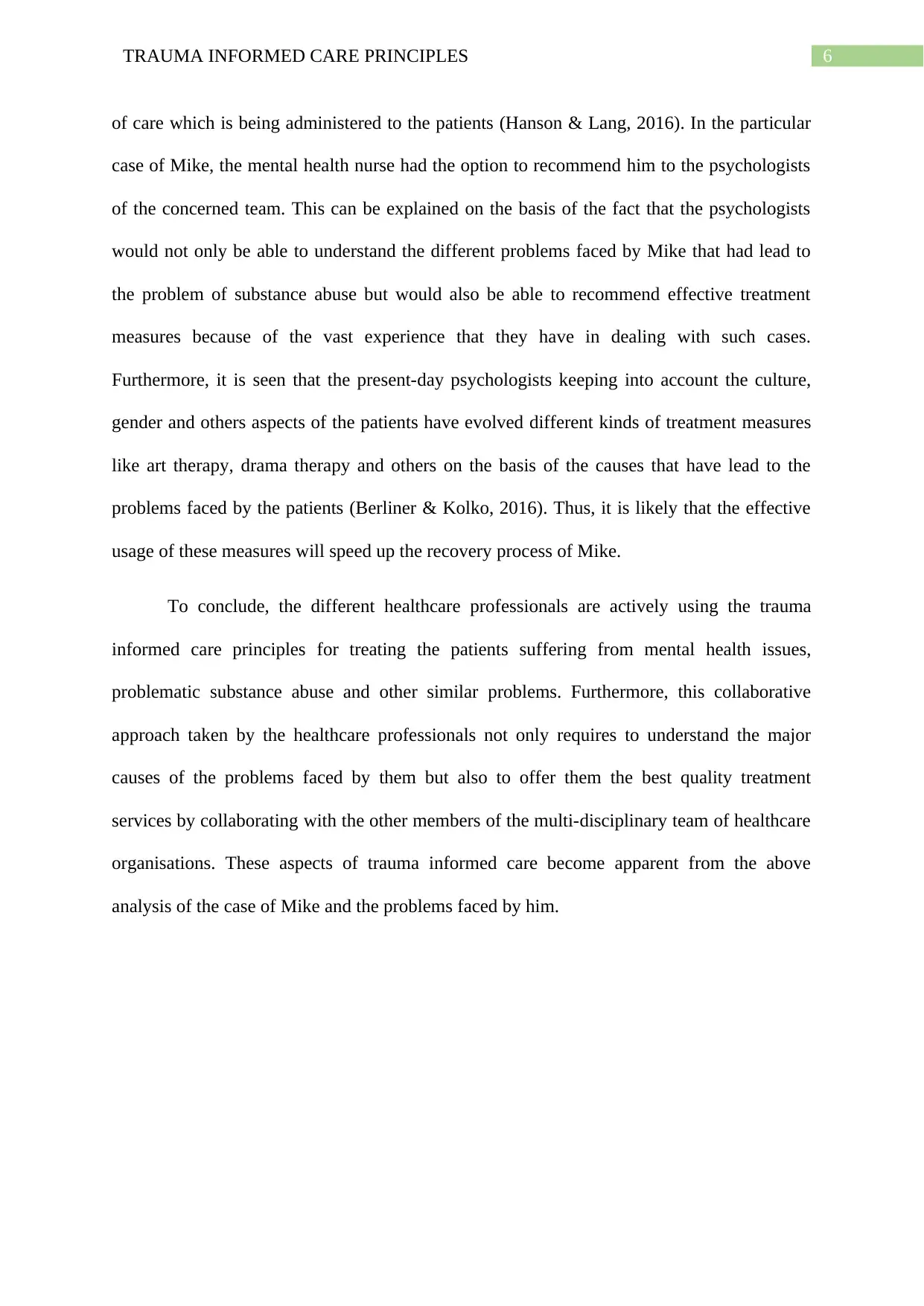
6TRAUMA INFORMED CARE PRINCIPLES
of care which is being administered to the patients (Hanson & Lang, 2016). In the particular
case of Mike, the mental health nurse had the option to recommend him to the psychologists
of the concerned team. This can be explained on the basis of the fact that the psychologists
would not only be able to understand the different problems faced by Mike that had lead to
the problem of substance abuse but would also be able to recommend effective treatment
measures because of the vast experience that they have in dealing with such cases.
Furthermore, it is seen that the present-day psychologists keeping into account the culture,
gender and others aspects of the patients have evolved different kinds of treatment measures
like art therapy, drama therapy and others on the basis of the causes that have lead to the
problems faced by the patients (Berliner & Kolko, 2016). Thus, it is likely that the effective
usage of these measures will speed up the recovery process of Mike.
To conclude, the different healthcare professionals are actively using the trauma
informed care principles for treating the patients suffering from mental health issues,
problematic substance abuse and other similar problems. Furthermore, this collaborative
approach taken by the healthcare professionals not only requires to understand the major
causes of the problems faced by them but also to offer them the best quality treatment
services by collaborating with the other members of the multi-disciplinary team of healthcare
organisations. These aspects of trauma informed care become apparent from the above
analysis of the case of Mike and the problems faced by him.
of care which is being administered to the patients (Hanson & Lang, 2016). In the particular
case of Mike, the mental health nurse had the option to recommend him to the psychologists
of the concerned team. This can be explained on the basis of the fact that the psychologists
would not only be able to understand the different problems faced by Mike that had lead to
the problem of substance abuse but would also be able to recommend effective treatment
measures because of the vast experience that they have in dealing with such cases.
Furthermore, it is seen that the present-day psychologists keeping into account the culture,
gender and others aspects of the patients have evolved different kinds of treatment measures
like art therapy, drama therapy and others on the basis of the causes that have lead to the
problems faced by the patients (Berliner & Kolko, 2016). Thus, it is likely that the effective
usage of these measures will speed up the recovery process of Mike.
To conclude, the different healthcare professionals are actively using the trauma
informed care principles for treating the patients suffering from mental health issues,
problematic substance abuse and other similar problems. Furthermore, this collaborative
approach taken by the healthcare professionals not only requires to understand the major
causes of the problems faced by them but also to offer them the best quality treatment
services by collaborating with the other members of the multi-disciplinary team of healthcare
organisations. These aspects of trauma informed care become apparent from the above
analysis of the case of Mike and the problems faced by him.
Paraphrase This Document
Need a fresh take? Get an instant paraphrase of this document with our AI Paraphraser
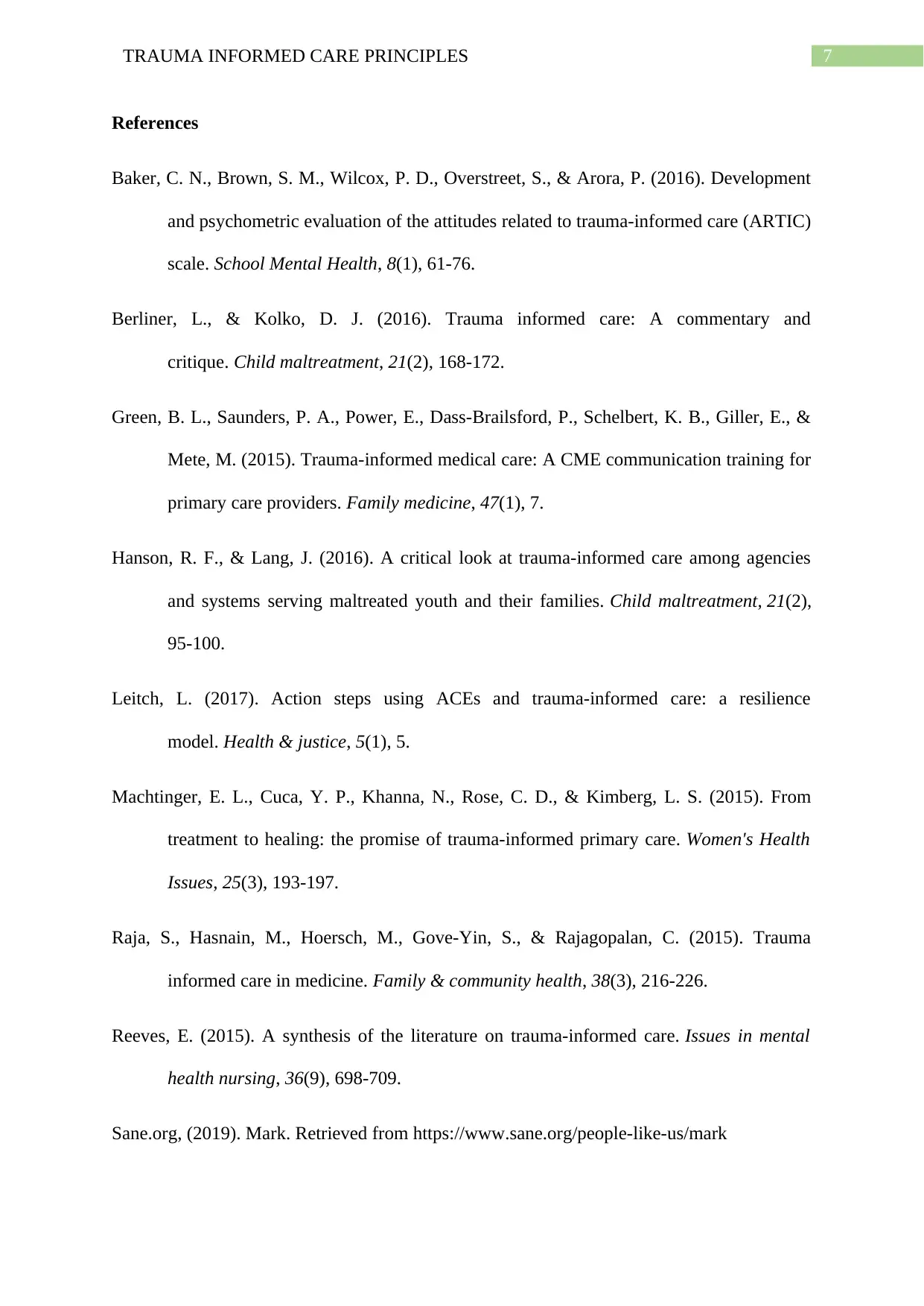
7TRAUMA INFORMED CARE PRINCIPLES
References
Baker, C. N., Brown, S. M., Wilcox, P. D., Overstreet, S., & Arora, P. (2016). Development
and psychometric evaluation of the attitudes related to trauma-informed care (ARTIC)
scale. School Mental Health, 8(1), 61-76.
Berliner, L., & Kolko, D. J. (2016). Trauma informed care: A commentary and
critique. Child maltreatment, 21(2), 168-172.
Green, B. L., Saunders, P. A., Power, E., Dass-Brailsford, P., Schelbert, K. B., Giller, E., &
Mete, M. (2015). Trauma-informed medical care: A CME communication training for
primary care providers. Family medicine, 47(1), 7.
Hanson, R. F., & Lang, J. (2016). A critical look at trauma-informed care among agencies
and systems serving maltreated youth and their families. Child maltreatment, 21(2),
95-100.
Leitch, L. (2017). Action steps using ACEs and trauma-informed care: a resilience
model. Health & justice, 5(1), 5.
Machtinger, E. L., Cuca, Y. P., Khanna, N., Rose, C. D., & Kimberg, L. S. (2015). From
treatment to healing: the promise of trauma-informed primary care. Women's Health
Issues, 25(3), 193-197.
Raja, S., Hasnain, M., Hoersch, M., Gove-Yin, S., & Rajagopalan, C. (2015). Trauma
informed care in medicine. Family & community health, 38(3), 216-226.
Reeves, E. (2015). A synthesis of the literature on trauma-informed care. Issues in mental
health nursing, 36(9), 698-709.
Sane.org, (2019). Mark. Retrieved from https://www.sane.org/people-like-us/mark
References
Baker, C. N., Brown, S. M., Wilcox, P. D., Overstreet, S., & Arora, P. (2016). Development
and psychometric evaluation of the attitudes related to trauma-informed care (ARTIC)
scale. School Mental Health, 8(1), 61-76.
Berliner, L., & Kolko, D. J. (2016). Trauma informed care: A commentary and
critique. Child maltreatment, 21(2), 168-172.
Green, B. L., Saunders, P. A., Power, E., Dass-Brailsford, P., Schelbert, K. B., Giller, E., &
Mete, M. (2015). Trauma-informed medical care: A CME communication training for
primary care providers. Family medicine, 47(1), 7.
Hanson, R. F., & Lang, J. (2016). A critical look at trauma-informed care among agencies
and systems serving maltreated youth and their families. Child maltreatment, 21(2),
95-100.
Leitch, L. (2017). Action steps using ACEs and trauma-informed care: a resilience
model. Health & justice, 5(1), 5.
Machtinger, E. L., Cuca, Y. P., Khanna, N., Rose, C. D., & Kimberg, L. S. (2015). From
treatment to healing: the promise of trauma-informed primary care. Women's Health
Issues, 25(3), 193-197.
Raja, S., Hasnain, M., Hoersch, M., Gove-Yin, S., & Rajagopalan, C. (2015). Trauma
informed care in medicine. Family & community health, 38(3), 216-226.
Reeves, E. (2015). A synthesis of the literature on trauma-informed care. Issues in mental
health nursing, 36(9), 698-709.
Sane.org, (2019). Mark. Retrieved from https://www.sane.org/people-like-us/mark

8TRAUMA INFORMED CARE PRINCIPLES
Traumainformedcareproject.org, (2019). Trauma Informed Care. Retrieved from
http://www.traumainformedcareproject.org/
Traumainformedcareproject.org, (2019). Trauma Informed Care. Retrieved from
http://www.traumainformedcareproject.org/
⊘ This is a preview!⊘
Do you want full access?
Subscribe today to unlock all pages.

Trusted by 1+ million students worldwide
1 out of 9
Related Documents
Your All-in-One AI-Powered Toolkit for Academic Success.
+13062052269
info@desklib.com
Available 24*7 on WhatsApp / Email
![[object Object]](/_next/static/media/star-bottom.7253800d.svg)
Unlock your academic potential
Copyright © 2020–2025 A2Z Services. All Rights Reserved. Developed and managed by ZUCOL.





